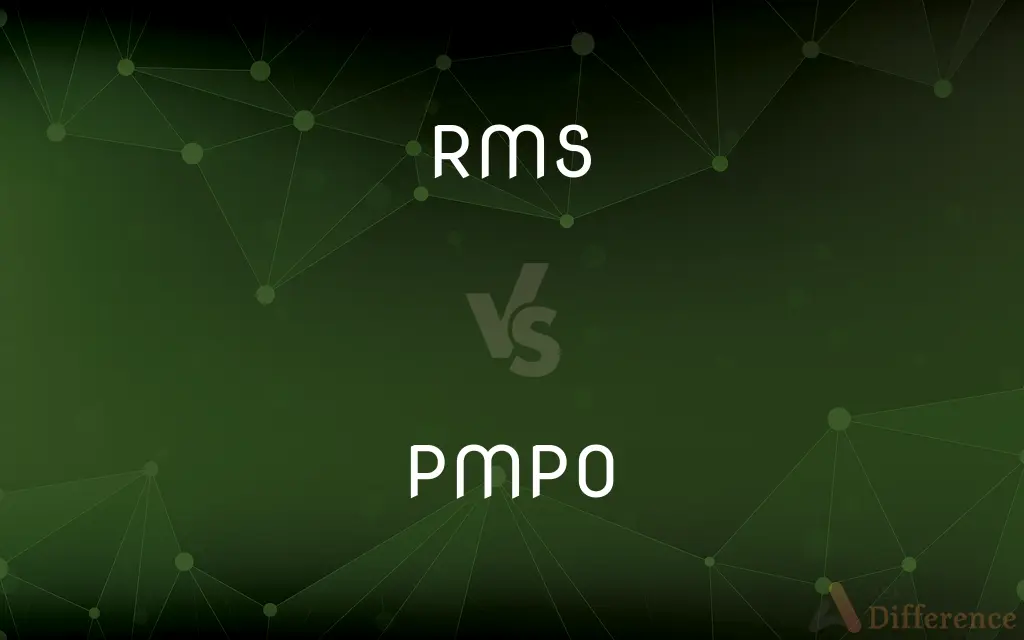RMS vs. PMPO — What's the Difference?
By Tayyaba Rehman — Published on January 26, 2024
RMS (Root Mean Square) measures the continuous power handling of a speaker, reflecting realistic usage, while PMPO (Peak Music Power Output) indicates the maximum power output in short bursts, often seen as less representative of actual performance.

Difference Between RMS and PMPO
Table of Contents
ADVERTISEMENT
Key Differences
RMS power is a more accurate and reliable measure of a speaker's performance, indicating how much continuous power it can handle. PMPO, on the other hand, represents a theoretical maximum power output, often for short durations.
RMS values are lower but more meaningful for understanding everyday usage and sound quality. PMPO values are usually much higher, but they can be misleading as they don’t reflect normal operating conditions.
The calculation of RMS is based on a mathematical formula that considers the average power output over time. PMPO is often calculated using less standardized methods, leading to inflated and inconsistent values.
Consumers seeking reliable information about speaker performance should look at RMS ratings. PMPO, while eye-catching on product specifications, offers less practical insight into actual performance.
RMS ratings are crucial for comparing the true power and quality of audio equipment. PMPO ratings, though commonly used in marketing, are not as useful for comparing different speakers or systems.
ADVERTISEMENT
Comparison Chart
Power Measurement
Continuous power handling
Maximum power in short bursts
Relevance
Reflects realistic, everyday usage
Theoretical, less representative
Calculation Method
Mathematical, consistent
Less standardized, often inflated
Utility for Consumers
Reliable for comparing performance
Less practical for true performance insight
Typical Values
Lower, but more meaningful
Higher, but potentially misleading
Compare with Definitions
RMS
Calculated using a mathematical average.
The RMS value is important for understanding the speaker's real-world performance.
PMPO
Often used in marketing to highlight power capability.
This system's PMPO rating is impressive, but it may not reflect everyday use.
RMS
Lower than PMPO but more accurate.
Despite having a lower RMS power, this speaker delivers consistent quality.
PMPO
Tends to be higher than RMS but less representative.
The PMPO figure is high, but I'm more interested in the RMS for actual performance.
RMS
Provides a realistic measure of speaker performance.
When comparing speakers, I always look at the RMS power ratings.
PMPO
Calculated using less standardized methods.
The PMPO value, while high, is not as reliable as the RMS rating.
RMS
Crucial for comparing audio equipment power and quality.
The RMS rating is a reliable indicator of how loud this system can play without distortion.
PMPO
Represents the maximum power output a speaker can achieve in bursts.
The speaker has a PMPO of 1000 watts, indicating its peak power potential.
RMS
Indicates the continuous power a speaker can handle.
This speaker's RMS rating of 50 watts means it can reliably handle up to 50 watts continuously.
PMPO
Less useful for practical comparison of speaker performance.
When choosing a speaker, I focus less on PMPO and more on RMS values.
Common Curiosities
What does RMS stand for in audio equipment?
Root Mean Square, indicating continuous power handling.
Are RMS values consistent across all audio devices?
While the method of calculating RMS is consistent, the actual values can vary based on the device's capabilities.
How is RMS power calculated?
It's calculated using a mathematical formula considering the average power output over time.
Why do manufacturers use PMPO in marketing?
PMPO figures are higher and more appealing in marketing, though they're less practical.
Is PMPO a reliable indicator of speaker quality?
No, PMPO is often inflated and less indicative of actual speaker performance.
Why is RMS more important than PMPO for consumers?
RMS provides a more accurate representation of a speaker's performance in typical usage.
Can PMPO values be compared across different brands?
Comparing PMPO values is unreliable due to inconsistent calculation methods across brands.
Do higher PMPO ratings mean better sound quality?
Not necessarily, as PMPO doesn't directly correlate with sound quality.
Is PMPO relevant for professional audio equipment?
Professionals usually rely more on RMS values for accurate and reliable information.
What type of power rating should I look at when buying speakers?
Focus on the RMS rating for a more accurate assessment.
Does a higher RMS rating mean a speaker is louder?
Generally, a higher RMS rating can indicate a speaker's ability to handle more power and potentially produce louder sound.
Can I use PMPO to compare home theater systems?
It's better to use RMS for a more realistic comparison.
How does RMS affect the longevity of a speaker?
A speaker with an appropriate RMS rating for its use is less likely to suffer from wear or damage due to power handling.
Should I consider both RMS and PMPO when choosing a speaker?
Focus primarily on RMS for a realistic understanding of the speaker's capabilities; PMPO can be considered but with skepticism due to its less reliable nature.
What does a high PMPO value typically indicate?
It suggests the speaker's peak power output, but it's often an exaggerated figure.
Share Your Discovery

Previous Comparison
CMOS vs. TTL
Next Comparison
Kohler vs. GroheAuthor Spotlight
Written by
Tayyaba RehmanTayyaba Rehman is a distinguished writer, currently serving as a primary contributor to askdifference.com. As a researcher in semantics and etymology, Tayyaba's passion for the complexity of languages and their distinctions has found a perfect home on the platform. Tayyaba delves into the intricacies of language, distinguishing between commonly confused words and phrases, thereby providing clarity for readers worldwide.
















































